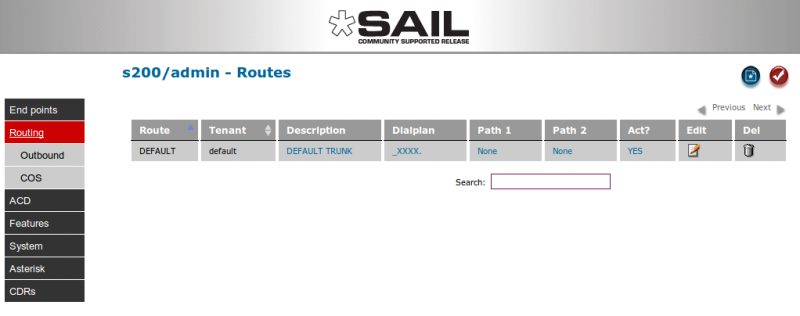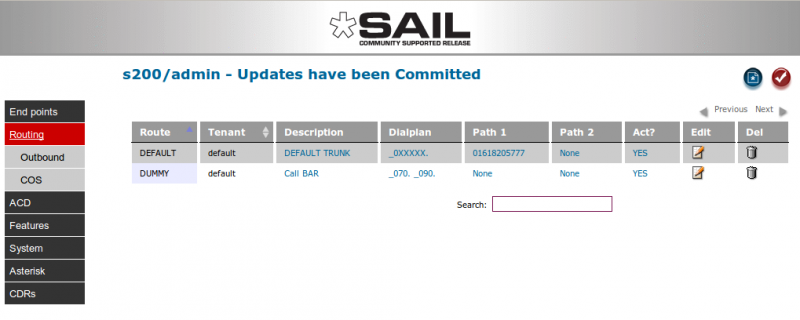SARK V4.0.0 Route
Contents
Outbound Call Routing
SARK schedules outbound calls onto specific trunks which you specify in route entries in the Outbound Panel. A route entry consists of a dialplan (in regular Asterisk dialplan format), together with a list of up to 4 paths, or trunks, which the dialler will use to place a call. Paths are selected in sequence, so the dialler will always first despatch a qualifying call onto trunk #1 and only if the trunk is unavailable will it attempt to use trunk #2, trunk #3 and so on. The dialplan serves as a filter to select calls which this route will handle, for example national calls, premium rate calls and so on, indeed any class of dial which can be characterised by the digits that comprise it.
Out-of-the-box, SARK has a single default route defined. It is a general catch-all which will take any dialled number longer than 4 digits and attempt to route it to "None", i.e., nowhere.
You can route calls that match the default dial-plan by simply specifying a trunk for them to use. For many applications that is enough, simply because there will often only be one physical trunk available to carry the calls and so everything will use that pathway. Of course you will want to augment this route by including any numbers less than 5 digits (for example, 999, 911, 112 and so on) that you also want to send out over the trunk.
Using multiple trunks on the same route
You can specify up to 4 different trunks to carry your calls in any given route. There are 2 "path" drop downs on the main panel and a further 2 in the edit panel. These trunks form a group which can be specified as "failover" or "balanced".
- Failover trunk groups
- The way this works is that the trunks will fail-over from one to the other in the event that a trunk becomes unavailable. This is useful if you have a VoIP trunk to carry all of your main traffic and perhaps an ISDN trunk to fail-over to should the internet line fail for any reason.
- Balanced Trunk Groups
- In a balanced group, calls will be evenly spread over the available trunks so that they are all used at roughly the same rate. This is useful for balancing calls across multiple circuits (for example PRI or GSM) where call plans require the trunks to all be used at the same rate.
Using multiple routes
You can also create multiple routes to route different classes of outbound call over different trunks. For example, you may wish to only send calls to the emergency services across an ISDN or analogue trunk or you may wish to send calls to cellphones only over a GSM gateway or international calls over a particular SIP carrier. This allows great flexibility in how you send calls across the Internat and PSTN networks.
Using "None" or dummy routes
It is often useful to create a route which goes nowhere. You can use this to "bar" calls to particular numbers or number classes for all users on the system. Users who dial a number which is filtered by a route which goes nowhere will receive a fast busy tone at the handset. In the example below we have create a route called DUMMY and in it we've barred calls to numbers beginning 070 and 090; these correspond to personal numbers and premium rate numbers in the UK, both of which carry high toll rates.
"None", or "Dummy" routes, will bar ALL users from dialling a particular dial pattern. However, there are also ways to bar individuals or groups with a feature called Class of Service (CoS).

